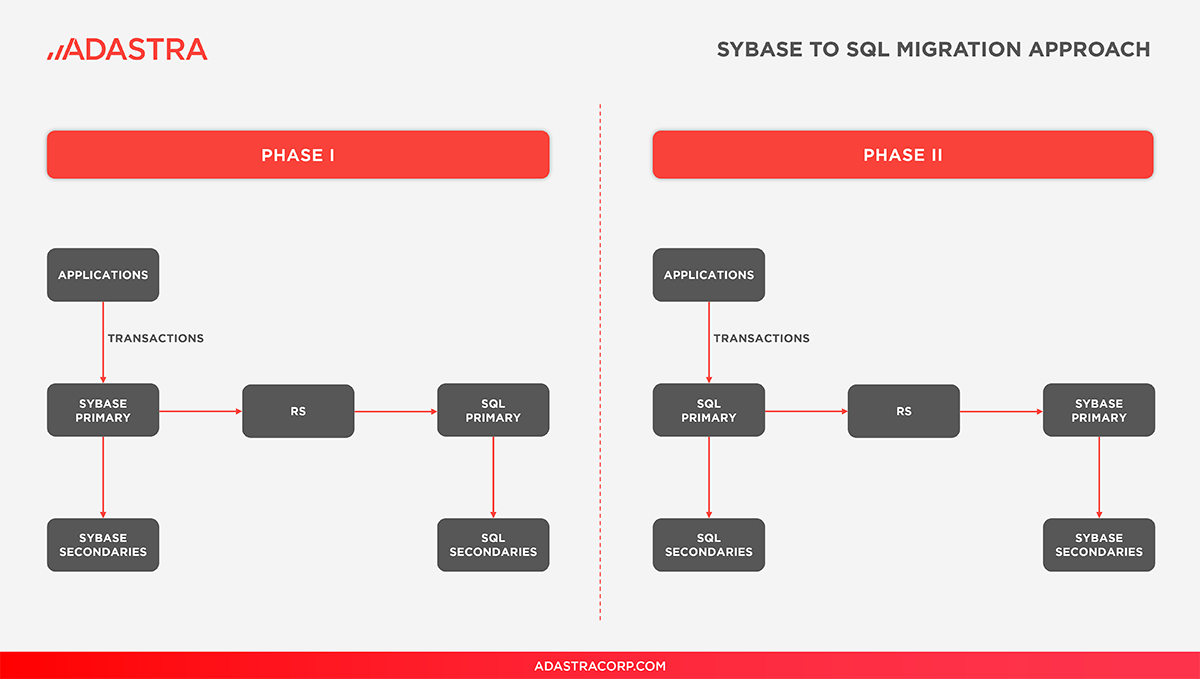97% Savings Through Sybase to SQL Server Migration
The client wanted to take a conservative approach and avoid the risk of moving from Sybase on-prem to SQL in the cloud in one go, and ultimately decided to migrate from Sybase to on-premise SQL Server.
databases and 7000 objects migrated
savings on budget estimation
availability
Background and Problem
Our client had been using a Sybase Relational Database Management System to support its mission-critical customer-facing platform and other essential applications. With Sybase scheduled to go out of SAP support by 2025, the client knew that their database would soon be unsupportable and wanted to migrate to an alternative database server.
The client wanted to take a conservative approach and avoid the risk of moving from Sybase on-prem to SQL in the cloud in one go, and ultimately decided to migrate from Sybase to on-premise SQL Server.
Why Zelusit?
Our partner, Microsoft, introduced Zelusit to the client during the period where they were considering alternative database servers and partners for the migration implementation. Zelusit had some initial discovery discussions with the client, and based on those, proposed our migration approach. The client found our approach to be in-line with their expectations and trusted our team to deliver a successful migration, and we were brought it for the project implementation.
Zelusit’s Approach and Solution
The project involved the migration of 12 different Databases across five applications from the Sybase environment to on-premise SQL Server.
Zelusit’s experts started off with a discovery exercise, analyzing the existing databases and applications to understand the source data systems and the current mappings from source to target systems. These would inform our migration approach from Sybase to SQL Server. There were certain functions and capabilities that existed in Sybase but not in SQL Server, and some custom developed functions which would need to be refactored and/or reengineered as part of the migration.
The discovery and fit-gap analysis helped our team assess what could be migrated natively without any challenges, and what customizations and configurations would have to be developed manually to fit SQL Server. By the end of this stage, our team had prepared a detailed project schedule, risk log, and resource plan.
Given the mission-critical nature of the applications and the underlying databases, the client wanted to ensure that they could fall back to their existing system, in the disaster situation that the migration did not work as planned. We used a combination of the existing Sybase Replication Server and Attunity Replication Server to facilitate bi-directional replication (Sybase to SQL and SQL to Sybase) and performed POCs for both Sybase to SQL and SQL to Sybase replication.
Evaluation reports and validation scripts were created for both POCs, to ensure that they had a proven methodology and set of tools for bi-directional replication, and we prepared reports confirming data validation for ongoing replication. We also developed and documented a Data Migration and Validation approach and finalized a list of tools for automated data validation.

Illustration: Sybase to SQL Migration Approach
The next step was the standing up or installation and configuration of multiple non-production SQL Server environments. This involved the development of automated scripts, and documentation of the final state architecture and installation and configuration steps.
We then started migrating schemas and objects using SQL Server Migration Assistant (SSMA), to automatically migrate everything that did not need intervention. In several cases, additional schema optimization was needed to optimize for the SQL Server platform and over 7000 objects and schemas were migrated in three cycles. In addition to the straight-forward database object migrations, our team also replicated the design and implementation of several automation and maintenance jobs in the new environment. Next, we installed and configured the production SQL Server environment. We also automated data comparison between Sybase and SQL during the parallel run and cutover windows.
To ensure that the client’s customers’ access to the platform would not be affected, we performed the migration over a long weekend without any system downtime and minimal disruption to the current production environment. Dry runs for “Go Live” were, therefore, a key element of the project, as all the historical data had to be migrated from Sybase to SQL Server within a specified time frame.
We performed 7 iterations of the cutover in test mode to ensure that we could migrate all the data, at the required level of performance, in the given timeframe. This required changes in our overall project plan and resourcing mix but was seamlessly managed without any delays. We also ensured high system availability with geo DR (disaster recovery) and redundancy.
Zelusit provided knowledge transfer and post Go Live support for six weeks after the completion of the migration to allow the client to adjust to the new environment and reach out to us in case of any issues.
Impact
- 12 databases and 7000 objects migrated
- 97% savings on budget estimation
- 97% availability
- Platform stability
- Enhanced data validation
- Bi-directional replication enabled
- Easy move to cloud
The primary benefit for the client was the ability to maintain the stability and scalability of this mission-critical customer-facing platform. With Sybase scheduled to go out of support, migrating to an alternative Relational Database Management System was essential to the client’s business, and we planned and executed this migration on time and within 3% of the estimated budget. The project was implemented with minimal disruption to the existing production system, zero data loss, and without any inconvenience to their customers. The new environment was designed to deliver 99.97% or better availability.
As a fall back, Zelusit performed bi-directional replication from Sybase to SQL Server and from SQL Server to Sybase, so that the client could migrate back to their earlier system if needed. This was supported by proper documentation of the tools and methodology, and we ensured appropriate knowledge transfer to and training of the client’s team on the migration approach.
The migration to on-premise SQL Server will also serve as a conservative step towards the client’s move to the cloud in the future. This project will make it easier and faster for the client to migrate to the cloud by simply porting their SQL Server instance across to Synapse or SQL Server Managed instance.
Need help migrating from your existing systems to more a modern on-prem or cloud system? Schedule a meeting with our experts.


